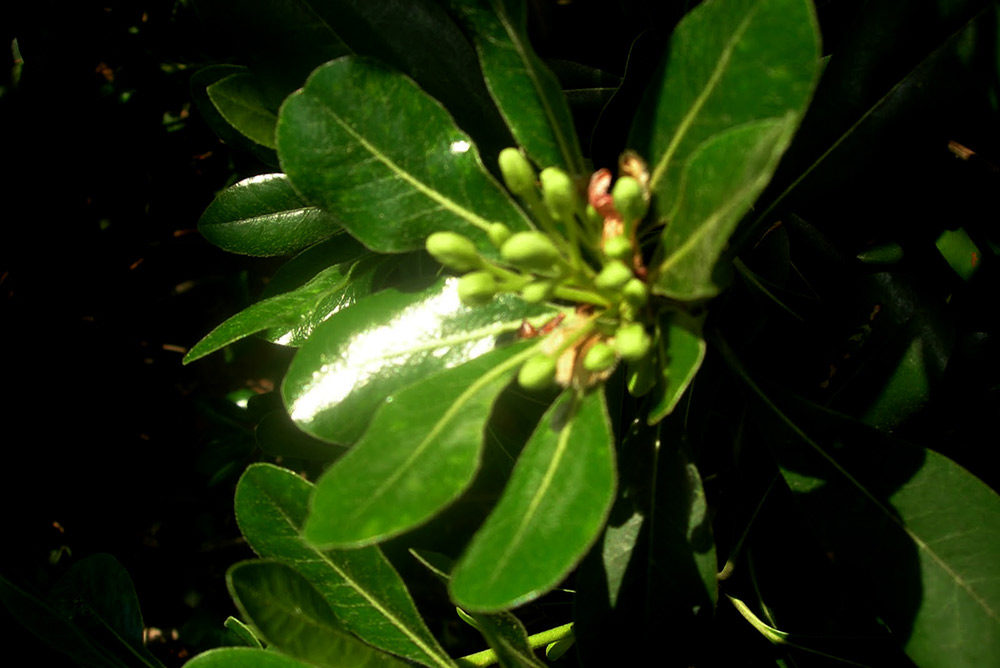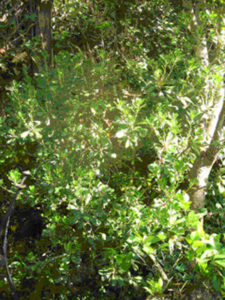
An actual bud from a year when the pittosporum actually bloomed. / Photo by Stephanie Cavanaugh.
WARNING: This story contains violent imagery.
I am mourning the loss of the pittosporum, even though this shrub has been a hit or miss affair since we trotted it back from a springtime trip to Savannah, Georgia, some five, six, seven, or maybe eight years ago. Could have been 10.
This was the last weekend of the summer garden, time to catalogue the tragic and the triumphant before everything is yanked and the tropicals move inside for the winter. The tulips are sitting in their bags ready to be buried deeply enough to avoid the squirrels, which make a game of their discovery.
To the pittosporum I say a semi-fond adieu.
Given its tropical nature, there was no reason to expect it to last as long as it did.
It’s a nice-looking border shrub, but when in bloom its little white flowers have a scent that smashes you over the head so mightily that even My Prince, who is odor blind, notices it. Like orange syrup with a hint of vanilla. Like a Disney fantasy of Florida (albeit one tragically without absurdist Carl Hiaasen). Like heat and sun and endless summer. Wherever you stroll in Savannah, the springtime scent of pittosporum curls its scented fingers and lures your nose to hover. MMMMMMMMMMPF, you inhale. FFFFFFFFFFFT, you exhale. MMMMMMMMMMPF . . . and so on, into delirium. And then you grow numb with it all and have to lie down for a good bit. Or at least I do.
Of course we had to have one.

The pittosporum doing nothing but taking up space, its usual mode. / Photo by Stephanie Cavanaugh.
We traipsed about with a flower I’d furtively pinched, assaulting people on the street and popping in and out of hotels and restaurants, yanking at the sleeves of those we thought should know: “What is this,” we’d say and say.
And invariably the reaction was an audible shrug. Seems this stuff is common as dirt in Savannah. So common no one needs to bother to know what it’s even called.
It was a doorman, I think, who told us the name, which we wrote down, and who directed us up a road that led to a garden center. A very long, hot road, where suddenly the jungle lush of Savannah disappeared and cars kicked up plumes of dust and my flip-flops began slurping against the asphalt.
But onward we trudged, for I don’t know how far, but at last a rather seedy-looking plant center materialized and we approached the genial-looking man who ran it and waved our slip of paper and now rather sadly wilted stem, and he drawled, “Aha. Over hee-ahh . . . ”
And yes, there they were. He said it’s only the tall-growing variety that will flower—that’s what he called it: Tall Growing Pittosporum.
Then he warned us that they would not grow up north. Frost, ya know. But we don’t listen to warnings, do we? And sometimes that works out fine and sometimes it doesn’t and this time it turned into a very little bit of this and a little bit more of that.
For a few years we babied the plant, keeping it in the dining room through the winter where it sat and did nothing but grow paler and more sickly-looking, limping through the cold months. Come spring, we’d move it out into the garden, where it would grow flower-free but immensely perky.
Immense being the operative word.
After a few rounds it grew too big to move and I left it in the garden with a intense sigh of probable farewell . . . but it made it through, thanks to a reasonably mild winter, I assumed. And, lo! It even flowered.
Unfortunately, there was a rather noisy conflict of scents between it, the honeysuckle and the mock orange all blooming simultaneously and quite vociferously. It was a bit overwhelming.
The next year we had no flowers. Oh, it looked like it was covered with buds, but it fooled me. Each branch bunched up at the end, swelling into a cluster of greenish bubbles and then with a gigantic SPRAHHHH bolted out a spray of . . . new leaves.
Feh.
Happened again the next year too, and then several more. But at least it was alive . . . though what good that was doing me was a wonder. Just growing bushier each year, it was taking up otherwise useful flowering space with a swath of glossy greenness.
I began to hope for its death. We don’t have room for nonperformance.
In desperation I called the Savannah Flower Something-or-Other and the nice lady, after telling me that the pittosporum should be dead (given that I’m attempting to grow a southern plant in what southerners consider the north), suggested a dose of Holly-tone plant food in early spring and again in the fall. Said it works for her.
So that fall and spring I fed it the Holly-tone and waited and the bunching began and my heart when ta-thud ta-thud but instead of leaves we had, miraculously, flowers!
And then this year it went belly-up for no particular reason that I could see, and My Prince unceremoniously yanked it up by its mighty roots and hauled the remains to the dump. One would think, as a lapsed Catholic, he’d have some appreciation for mourning and pageantry and decorum and so forth (he’d look quite handsome in one of those little white collars, whatever their called). The plant’s disposal [Warning! You may wish to avert your eyes here] reminded me of the time a favorite and particularly fat and friendly goldfish died and My Prince dropped it in the trash masher.
The sound of the grinding of its golden body still gives me chills.
—Stephanie Cavanaugh
LittleBird Stephanie is working on a book about urban gardening. To read her earlier columns, go to the Search field at the top right of the page and search for Green Acre.
